Storage Area Networking is a term used to describe one of the most popular uses of Fibre Channel. While the benefits of SAN have been long apparent, it was only with the advent of Fibre Channel that massive adoption of open SAN topology became feasible.
Storage networking involves amassing large volumes of data and distributing it. The actual network that evolves from storage networking is known as a Storage Area Network (SAN). Preeminent storage networks are based on Fibre Channel technology and are known as Fibre Channel Storage Area Networks or Fibre Channel SANs. In this publication, all SANs are based on Fibre Channel technology.
Fibre Channel SANs encompass the connection between storage and servers, as seen in Figure1. SANs service a limited number of servers that distribute data to a large number of users over an Internet Protocol (IP) network such as Ethernet. The close-knit Fibre Channel network, known as a fabric, is optimized for large data transfers with low overhead, low-latency switching, and minimal interruptions to the flow of data. A typical user would not have a direct connection to the SAN but would access the data stored in the SAN via a server on the IP network. Fibre Channel increases the performance of data transfers to levels that are unmatched by any other technology.
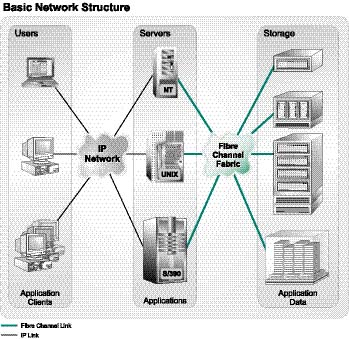
Figure 1: Fibre Channel SANs connect hundreds of servers to storage while IP networks connect thousands of users to the servers in client/server environments. The Fibre Channel fabric is optimized for large block transfer of data while the IP network is optimized for small file transfers.
The benefits of SANs are directly related to the increased accessibility and manageability of data offered by the Fibre Channel architecture. Data becomes more accessible when the Fibre Channel fabric scales to encompass hundreds of storage devices and servers. The data is also more available when multiple concurrent transactions can be sent across Fibre Channel’s switched architecture. Fibre Channel also overcomes distance limitations when Fibre Channel links span hundreds of kilometers or are sent over a wide area network (WAN). Finally, the Fibre Channel foundation enables improved management of terabytes of data. Fibre Channel successfully addresses the requirements of data centers that grow at exponential rates.
Figure2 shows how SANs allow multiple servers to access multiple storage devices while captive Small Computer Systems Interface (SCSI) storage can only be accessed by servers directly attached to the SCSI bus. Many supplemental advancements in storage management and security have been built on the Fibre Channel foundation to enhance the manageability and applicability of SANs.

Figure 2: Traditional open storage networks based on the SCSI architecture limit the scalability, availability, and distance of the storage network. SANs based on Fibre Channel’s switched serial architecture go beyond each of these limitations and offer advancements in management and security.
Storage Consolidation and Virtualization
With SANs. Data can be moved from one storage device to another to optimize configurations. Since Fibre Channel can have multiple initiators, multiple servers can access the same storage device. As Figure3 shows, reconfiguring data can free up entire storage devices for other applications. Storage in SANs is independent of servers, so it can be logically consolidated yet remain physically separated.
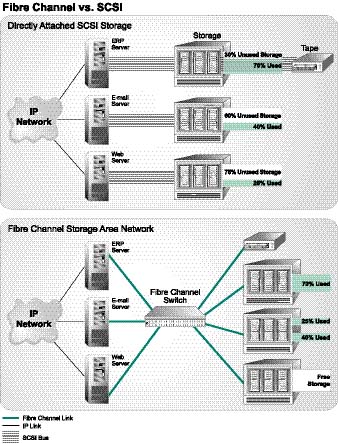
Figure 3: Traditional networks used captive SCSI storage for each server. As the number of applications and servers increases, the small problems of this architecture turn into big problems. Fibre Channel SANs offer a scalable solution where any server can access any storage device. The independence between servers and storage enables optimization of storage devices and increases performance over longer distances.
The availability of SCSI devices is limited because only one controller has serial access to devices. If a query to the third SCSI device occurs while data is written to the seventh device, the third device is denied use of the bus. Only one SCSI device on the SCSI bus is available at any one time. In a switched non-blocking Fibre Channel fabric, the use of one device will not affect the availability of other devices.
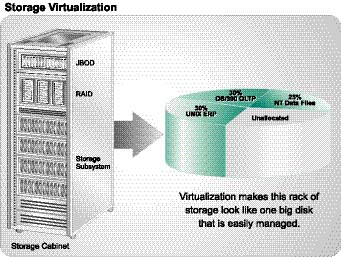
Figure 4: A SAN appliance virtualizes storage and has the effect of converting various storage devices into one big disk. This big virtual disk stores terabytes of data that can allocate storage to different applications quickly and painlessly. The management of many storage devices can also be controlled from one console.
Remote Mirroring
Disk mirroring is a simple concept, where data is written or mirrored to two or more storage devices when it is saved. When one disks fails, an identical copy still exists that can be readily accessed. Disk mirroring has been done for years with SCSI, but with SCSI’s distance limitation, the mirrored data usually remains in the same room as the primary copy. Fibre Channel has changed the paradigm under which mirroring operates.Now, whole storage subsystems and Redundant Arrays of Independent Disks (RAIDs) can be mirrored at remote sites.
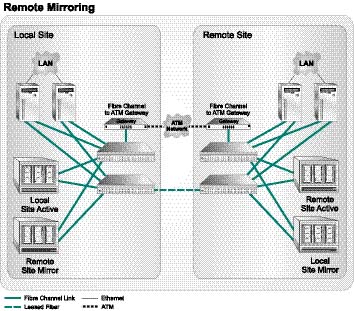
Figure 5: Remote mirroring over 100 kilometers prevents data loss due to localized disasters. Mirroring also provides multiple access points to the same data. This example utilizes leased fiber as well as the ATM network to redundantly connect two remote sites.
Storage Backup
Although data loss due to disk drive failure is prevented by mirroring, mirroring is not a cure for the primary reason for data loss – user error. Tape backup is a very cost-effective way to prevent active sources of data loss, such as user error or viruses. Old techniques of backing up a server over the LAN required two dedicated servers, two SCSI buses, and most of the LAN’s bandwidth, as seen in Figure6. Backing up data when the application is not running, i.e., cold backup, limits the availability of data. Daily backup of gigabytes of data can cause significant downtime.
The bottom half of Figure 6 illustrates new techniques of tape backup based on SAN technology that avoid these pitfalls. Backup software runs on a backup server and automates backup procedures. After the tape and storage device are attached to the Fibre Channel fabric, a LAN-free backup, where no backup traffic travels on the LAN, is possible. Advanced applications and backup software based on Fibre Channel technology can do hot backups with no downtime.
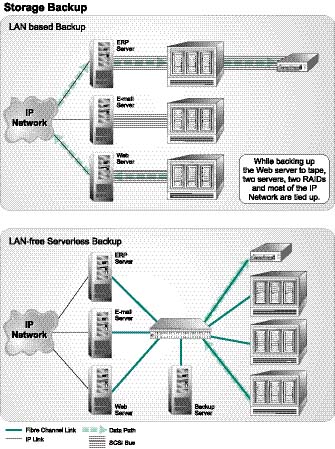
Figure 6: Traditional backups over the LAN cause significant availability problems and tie up several devices. SANs allow LAN-free, serverless backups of hot application data. This equates to zero downtime during backup.
Storage Management
Management software is a growing aspect of storage networking. SAN appliances or management software enable the IT staff to control a variety of storage devices, fabric elements, and even servers. A graphical representation of the entire fabric in the management software is often used to access the administrative features of each device. Enterprise management software allows management of the IP network as well as the heterogenous SAN from one access point. Management software automates and simplifies management of storage resources to ease the burden of controlling terabytes of data.
Policy-based management is a powerful management capability for SANs. Policy-based management allows different policies, such as backup schedules or resource allocation, to be deployed throughout the enterprise. Policies can be set up once and deployed across multiple platforms. Policy-based management follows the general trend of increased functionality with simplicity.








